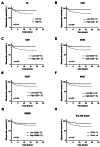Characterization of tumor-infiltrating lymphocytes and their spatial distribution in triple-negative breast cancer
- PMID: 39643914
- PMCID: PMC11622547
- DOI: 10.1186/s13058-024-01932-4
Characterization of tumor-infiltrating lymphocytes and their spatial distribution in triple-negative breast cancer
Abstract
Background: The tumor immune microenvironment, particularly tumor-infiltrating lymphocytes (TILs), plays a critical role in disease progression and treatment response in triple-negative breast cancers (TNBCs). This study was aimed to characterize the composition of TILs and investigate their clinicopathological and prognostic significance with a special focus on the spatial distribution of TILs in TNBCs.
Methods: We analyzed TNBC samples through PanCancer Immune Profiling using NanoString nCounter assays to identify immune-related genes that are expressed differentially in relation to TIL levels and evaluated protein expression of selected markers through immunohistochemical staining on tissue microarrays. For a comprehensive assessment of the expression of cytotoxic T lymphocyte (CTL) and natural killer (NK) cell markers, a CTL-NK score was devised based on CD8+, CD56+, CD57+, GNLY+, and GZMB+ TIL levels.
Results: Gene expression analysis revealed significant upregulation of CTL and NK cell-associated genes including GNLY, KLRC2, and GZMB in TIL-high TNBCs. Immunohistochemical validation confirmed that TNBCs with higher TILs had a greater amount of CD56+, CD57+, GNLY+, and GZMB+ TILs not only in absolute number but also in proportion relative to CD4+ or CD8+ TILs. High TIL and its subset (CD4+, CD8+, CD56+, CD57+, GNLY+, and GZMB+ TIL) infiltration correlated with favorable clinicopathological features of tumor. In survival analysis, high CTL-NK score was found to be an independent prognostic factor for better disease-free survival (DFS) of the patients. Furthermore, uniformly high TIL infiltration was linked to better DFS, whereas cases with heterogeneous TIL infiltration showed no difference in survival compared to those with uniformly low TIL infiltration.
Conclusion: Our study showed that CTL and NK cell-associated gene expression and protein levels differ significantly according to TIL levels and that CTL-NK score and distribution of TILs within tumors have a prognostic value. These findings emphasize the importance of CTLs and NK cells as well as the spatial uniformity of TIL infiltration in clinical outcome of TNBC patients, providing valuable insights for refining prognostic assessments and guiding immunotherapeutic strategies.
Keywords: Cytotoxic T lymphocyte; NK cell; Spatial distribution; Triple-negative breast cancer; Tumor infiltrating lymphocyte.
© 2024. The Author(s).
Conflict of interest statement
Declarations. Ethics approval and consent to participate: This study was approved by the institutional review board (IRB No B-2210-786-303), and the requirement of informed consent was waived. Consent for publication: Not applicable. Competing interests: The authors declare no competing interests.
Figures




References
-
- Perou CM, Sorlie T, Eisen MB, van de Rijn M, Jeffrey SS, Rees CA, Pollack JR, Ross DT, Johnsen H, Akslen LA, et al. Molecular portraits of human breast tumours. Nature. 2000;406(6797):747–52. - PubMed
-
- Leon-Ferre RA, Goetz MP. Advances in systemic therapies for triple negative breast cancer. BMJ. 2023;381:e071674. - PubMed
MeSH terms
Substances
Grants and funding
LinkOut - more resources
Full Text Sources
Research Materials

